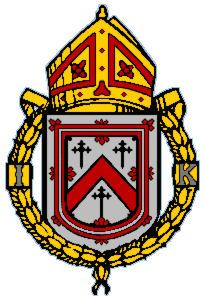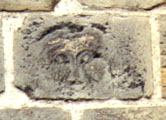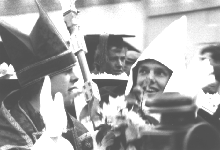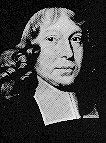 Earl of Arran Earl of Arran |
The Earl of Arran led the
seige against protestant reformers holding the castle
in 1546-1547. |
 St. Andrew, Apostle of Jesus St. Andrew, Apostle of Jesus |
St.
Andrew, the patron saint of Scotland was St. Peter's brother.
Formerly a fisherman, he became an apostle of Jesus.
 |
|
 Cardinal
David Beaton Cardinal
David Beaton
(1494-1546)
|
Archbishop
of St. Andrews. Known for his persecution of protestant reformers.
He was murdered shortly after
George Wishart was burned at the stake.
See also Scotland:
Famous People
 |
 Rev. Dr. Andrew Bell Rev. Dr. Andrew Bell
(1753 - 1832) |
The
founder of Madras College (1832), he was born in a house at 107
South Street. A native of, and student in, St. Andrews, and tutor
in Virginia; he became superintendent of a military school/orphanage
in Madras, India. There he developed the 'monitorial' system
of having older pupils tutor younger ones. A system which gained
wide acceptance. Dr. Bell was also founder of the Bell Baxter
High School in Cupar.
 |
 Sir
David Brewster Sir
David Brewster
(1781 - 1868) |
Is
famous for his contributions to optics especially microscopes,
and the invention of the Kaleidoscope (Greek: "beautiful
form to see"). In 1838 he became principal of the university |
 Paul Craw Paul Craw |
Paul
Craw was a refugee from Bohemia who taught the doctrines of John
Hus, sometimes referred to as the "Morning Star" of
the Reformation. The Bible translations of Tyndale and Wycliff
were begining to circulate in Scotland. He was burned at the
stake in Market Street in 1433. |
 Henry Forrest Henry Forrest |
Martyred
for confessing that he felt Patrick Hamilton's views were defensible.
He was suffocated privately, so as not to increase the public
outcry at Hamilton's death. |
 Patrick Hamilton Patrick Hamilton
 |
In 1528 Patrick
Hamilton was burned at the stake, outside
St.Salvators College. Legend has it that, as he died, the
image opposite appeared on the wall of St. Salvators clock tower.
Set in the cobblestones at the place where
he died are the initials "PH". Standing on these initials
is reputed to result in exam failure and other such salutory
repercussions for those who would carelessly trespass on his
memory.

|
 John Honey John Honey |
In
January 1800, John
Honey swam out to the wreck of the Janet of MacDuff, a sailing
vessel which had run aground and was being broken apart by a
storm. He resucued all five sailors.
The Computational Science building of the university is named
after him, and a stained glass window in the
chapel commemorates his heroism.
 |
 Bishop James Kennedy Bishop James Kennedy |
Uncle
of Kate Kennedy, it was he who taught
James II that an effective way of breaking the power of his nobles
was like breaking a bundle of arrows ... most easily done one
at a time.
 |
 Kate Kennedy Kate Kennedy |
 Bishop Kennedy and his niece Kate as depicted during
an annual "Kate Kennedy" procession. Bishop Kennedy and his niece Kate as depicted during
an annual "Kate Kennedy" procession. |
Kate
Kennedy is a somewhat mythical figure in St. Andrews' past.
She was the niece of Bishop James Kennedy.During
the procession, the part of Kate is played by a first year male
student (bejant)
 |
 Norman Leslie Norman Leslie |
Norman
Leslie was a leader of those protestants occupying the castle
during the seige of 1546 - 1547 |
 Dame Louisa Lumsden Dame Louisa Lumsden
(1840-1935) |
Louisa
Lumsden was one of the chief founders and first headmistress
of St. Leonard's School (1877). She also became Warden of University
Hall, and was created DBE in 1935.
 |
 Old Tom Morris Old Tom Morris
(1821-1908) |
Old Tom
Morris was born in St. Andrews and competed in every Open
Championship up to 1896. He won the Open four times and still
holds the record as the oldest winner in 1867, when he was 46
years old.
 |
 Young Tom Morris Young Tom Morris
(1851-1875) |
The
first recorded "hole in one" was made by Young
Tom Morris during the Open Championship at Prestwick in 1868. He won the championship four
years in a row; a feat which has not been equalled. His young
bride of just a year died in childbirth and Young Tom Morris
never recovered from the shock. He died just a few months later. |
 Walter Myln Walter Myln
(1558) |
Walter
Myln was burned at the stake outside Deans
Court. He is one of the martyrs commemorated by Martyrs Monument.
At the place where he died, protestant mobs burned statuary torn
from the cathedral when it was sacked in 1559 |
 John Knox (1505?-1572) John Knox (1505?-1572) |
The Thundering
Scot
 |
 St. Rule,also known as St.
Regulus (Latin) St. Rule,also known as St.
Regulus (Latin) |
Legend
has it that St. Rule, a Greek monk, was given a vision to bring
some of the relics of St. Andrew from Constantinople
to "the ends of the earth" for safety. What relics
there may have been have long since vanished, quite possibly
as a result of the ravages of the Reformation.
 |
 Samuel Rutherford Samuel Rutherford
(1600 - 1661) |

Samuel Rutherford |
In 1647 Rutherford was appointed principal
of St. Mary's at St. Andrews, and later, rector of the university.
He was preeminent in Scotland as a scholar and leader. He was
well known on the Continent and in 1648 and 1651 declined appointments
to Dutch universities. Rutherford is best known for his work
"Lex Rex" in which he assails the concept of the "Divine
Right" of kings and also for his pastoral
letters. The Restoration of Charles II in 1660 put him in
great peril. He was removed from office, but died on 29 March
1661 before the full fury of the storm of persecution broke.
 |
 Archbishop James Sharp (1618
- 1679) Archbishop James Sharp (1618
- 1679) |

Archbishop James Sharp in
his coach, as depicted in an annual Kate Kennedy Procession.
His coach is still said to continue it's journey at night and
noiselessly through the streets of St. Andrews. |
Archbishop Sharp was murdered by covenanters
at Magus Muir. His tomb is visible
inside Holy Trinity Church in South Street.Sharp had been heavily
in the service of the king in establishing the Episcopalian church
in Scotland. The covenanters
were zealously pursuing the
vision of the reformation of 100 years earlier where the church
was not headed by the King, indeed they owned no other king but
Jesus. This concept had been enshrined in several "covenants".
It seems that those who way-laid Sharp were actually expecting
another victim, but seized the opportunity and stabbed him some
16 times in full view of his daughter. Bishop Paterson, notorious
for inventing Thumb Screws, preached at Sharp's funeral.
 |
 Bishop Henry Wardlaw Bishop Henry Wardlaw |
Founder
of the University of St. Andrews (1411)
 |
 George Wishart (1513 -
1546) George Wishart (1513 -
1546) |
Protestant
Reformer and martyr. A plaque
outside the castle commemorates the place of his execution (marked
with the initials "GW" set in cobblestones. The Wishart
Society has an excellent page on the circumstances of his
martyrdom. (See also the Calvinist
Corner)
 |
 James
Wilson James
Wilson
(1742 - 1798) |
A
native of St. Andrews, emigrated to America in 1765. He was one
of only six people who was both a signer of the US Declaration
of Independence and a signer of the US constitution. He became
the first Justice of the US Supreme Court.
 |
 Prince William Prince William
(1982 - ) |
First son of Prince Charles, the Prince
of Wales and Princess Diana.
Educated at Eton and studying the History of Art at St Andrews. Prince William
is directly in line to the British throne.
Prince William matriculated
at the University in Spetember 2001.
(NOTE:
In order to help preserve the Prince's privacy, there will NOT
be extensive coverage of his university education at this site.)
|
For information on other characters
in St. Andrews' past ... select from the following list
|
|
 Further Reading Further Reading |